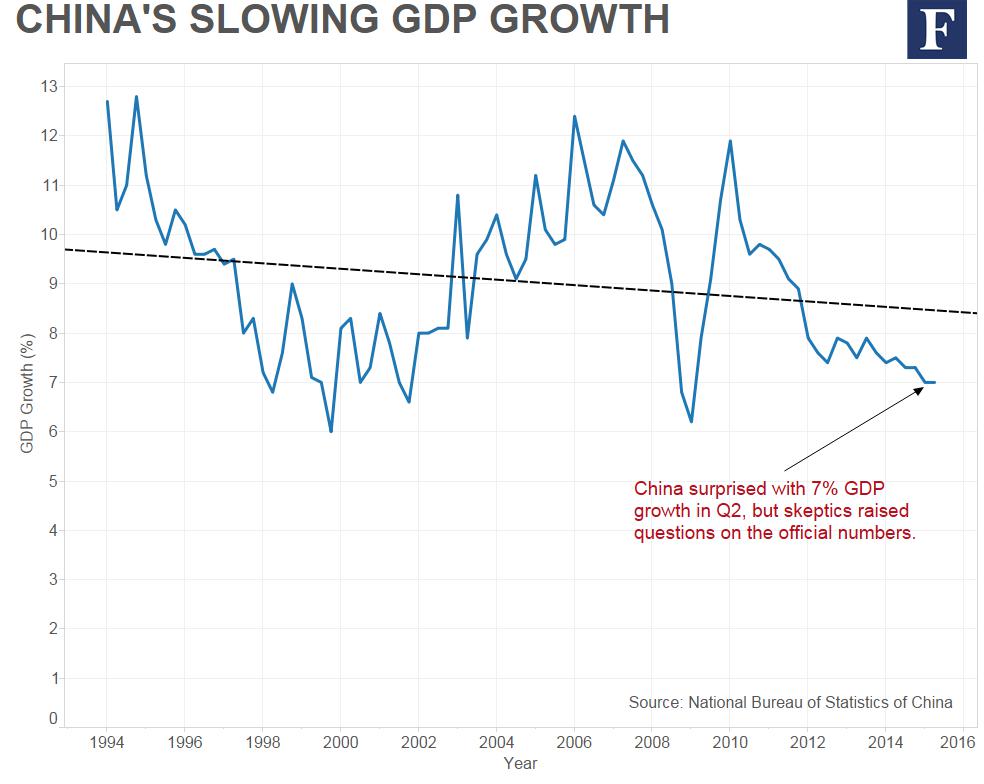Has the China bubble finally burst?
China’s major stock indexes extended its loss to a fourth straight day, with Shanghai Composite Index dropping nearly 7.6% on Tuesday. Despite U.S. stocks rebounded on Tuesday, the ongoing rout of China’s stock market has caused a roller coaster ride for Wall Street on Monday, with the Dow closing at 18-month low.
Much has been written about China’s growth trouble, but what are the key issues at stake that cause such turmoil in the global market? “In the short-term, investors are likely to take their cue from economic data and any policy actions or comments, particularly out of China,” wrote BlackRock’s global chief investment strategist Russ Koesterich. Thus, we compile a visual guide to understand the key concerns about China on top of the minds of Chinese and global investors.
Chart 1: Will GDP match the government’s promise?
From our partners:
When the government released its 7% estimate of second quarter GDP growth in July, many China watchers grew skeptical of the data’s validity. “Investors are now correct to be concerned about the future of China’s economy despite the government’s time-earned reputation of carefully managing GDP growth,” S&P Cap IQ’s Michael Thompson and Robert Keiser wrote in a note. It’s the No.1 reason why global investors are panicking – the decade-long stellar growth of the world’s second largest economy is decelerating faster than expected.
Chart 2: Will manufacturing continue to weaken?
For the past decade, China has been the world’s factory, pumping out products from electronics to clothes to auto parts. The preliminary Caixin China PMI (Purchasing Managers’ Index) shows that manufacturing activity fell to the lowest level since the financial crisis, another warning sign of slower-than-expected economic growth. “The weakness was broad-based, suggesting that the manufacturing sector continued to face the problems of overcapacity and weak demand,” J.P.Morgan’s Jahangir Aziz wrote in a note. Such bleak outlook will likely give pressure for more fiscal and monetary stimulus to stabilize growth from the Chinese government.
Chart 3: Can government intervention re-establish confidence?
After stocks tumbled on Tuesday, central bank People’s Bank of China slashed interest rates for the fifth time since November in its latest efforts to inject liquidity into the market. Since the stock market began freefalling from the record high in early June, the Chinese authorities have tightened their grip. They allowed almost half of stocks to halt trading and pumped $42 billion to purchase “blue chip” stocks, but these measures have failed to stabilize the market so far, except for injecting some short-term optimism. On Sunday, pension funds managed by local governments were granted permission to invest in public stocks for the first time – another measure to funnel capital into the equity market. Will another interest rate cut do the trick this time?
Chart 4: Will the yuan’s devaluation impact the Fed’s decision?
Allowing the yuan’s devaluation was one of the most shocking measures that the Chinese government took in recent months. The Chinese currency has been trending upward against the dollar in the past decade, so the sharp downward adjustment immediately sent Asian currencies tumbling this week. But the real question for investors is how such depreciation of the yuan, meaning a stronger dollar and more pressures from China’s exports, would impact U.S. inflation and therefore the Fed’s decision to raise interest rate.
Chart 5: Can the country’s imports and exports rebound?
One key reason for the yuan’s devaluation is the plunging exports for the world’s second largest economy. The country’s export has been the main driver of its double-digit growth for a decade and created millions of jobs that are essential to social stability. On the other hand, slower economic growth means that the country is importing fewer raw materials such as iron ore and oil, hurting commodities export-driven markets like Brazil, Russia, and Saudi Arabia. “What has occurred is a recognition of Chinese weakness, aggravating a downward trend in commodity prices,” RBC Capital Markets’ Chief U.S. market strategist Jonathan Golub wrote in a note.
Chart 6: Will the Chinese consumption growth live up to investors’ expectation?
The spending power of Chinese consumers has been the biggest story for companies not just China but also the rest of the world. “China GDP and consumption growth trends are highly relevant to U.S. corporate profitability not only because China represents the world’s second-largest economy but also because nearly half of S&P 500 Index member revenues now originate from non-domestic sources,” wrote S&P Cap IQ’s Thompson and Keiser. The loss of confidence in Chinese consumption growth is particularly a hard blow for companies with global reach and strong China exposure, such as mobile phone manufacturers.
This feature originally appeared in Forbes.























